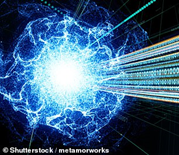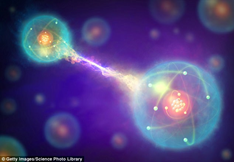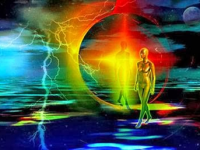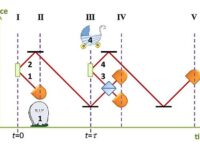• A long-pondered thought experiment finally get a laboratory test
• The result prove that two subjects with opposing observations can be right
• Findings challenge the fundamental nature of how science is conducted
By JAMES PERO FOR DAILYMAIL.COM
PUBLISHED: 21:32 GMT, 20 March 2019 | UPDATED: 21:34 GMT, 20 March 2019
In a new paper, researchers say they’ve proved that two realities can exist at once, at least when it comes to the quantum world.
To investigate their hypothesis, researchers at the Department of Experimental Physics at the University of Innsbrück in Austria tackled one of the world’s most confounding thought experiments, called ‘Wigner’s Friend.’
The experiment, named after its progenitor, the Nobel Prize-winning physicist Eugene Wigner, was posited in 1961 and involves two people observing the same thing — in this case, a single photon.

In the most recent studies, particles were given names (illustrated above) to represent fictional observers in the Wigner’s Friend experiment. In this, one person observes the photon, sending it to either a vertical or horizontal state, while Wigner, who is outside of the lab, runs a test to prove that the photon is still in a state of superposition
When the photon is observed, it is displayed in either a horizontal or vertical state, but according to quantum mechanics, before that observation is made, it exists in a state of ‘superposition’ meaning that it is in both states at once — horizontal and vertical.
In Wigner’s experiment, one person in a laboratory observes the photon, sending it to either a vertical or horizontal state, while Wigner, who is outside of the laboratory, runs a simple test called an ‘interference experiment’ to prove that the photon is still in a state of superposition.
In the thought experiment, both observations, and therefore both the realities they represent, can be proven to be true simultaneously.
While Wigner’s Friend has long just been an intriguing thought experiment, advances in the field of quantum mechanics and physics have allowed researchers to put the theory to the test — and that’s exactly what Massimiliano Proietti of Heriot-Watt University in Edinburgh and colleagues have done.
Using six entangled photons – particles of light whose fates are tied together — Proietti and colleagues were able to replicate the results of Wigner’s Friend.

The experiment involves two people observing the same thing — in this case, a single photon.
When observed, the photons existed in a state of polarization, but when tested using an interference experiments, it was concluded that photons still existed in a state of superposition.
The implications of the study not only confirm the long-discussed experiment, but challenge the foundation of how observations are made.
‘The scientific method relies on facts, established through repeated measurements and agreed upon universally, independently of who observed them,’ say Proietti in the paper published in pre-print journal AirXiv.
‘In quantum mechanics, the objectivity of observations is not so clear.’
However, if those facts can neither be proved right or wrong — or both — as Proietti’s work posits, then science itself may have to change.
WHAT IS QUANTUM ENTANGLEMENT?
In quantum physics, entangled particles remain connected so that actions performed by one affects the behaviour of the other, even if they are separated by huge distances.
This means if you measure, ‘up’ for the spin of one photon from an entangled pair, the spin of the other, measured an instant later, will be ‘down’ – even if the two are on opposite sides of the world.
Entanglement takes place when a part of particles interact physically.

In quantum physics, entangled particles remain connected so that actions performed by one affects the behaviour of the other, even if they are separated by huge distances (artist’s impression)
For instance, a laser beam fired through a certain type of crystal can cause individual light particles to be split into pairs of entangled photons.
The theory that so riled Einstein is also referred to as ‘spooky action at a distance’.
Einstein wasn’t happy with theory, because it suggested that information could travel faster than light.
What do you think about this piece? Share your comment in the comment thread and share the story using the social media buttons above. You may reach the editor on 0249579664. Thank you.

